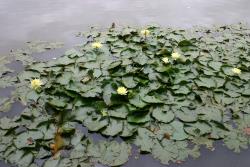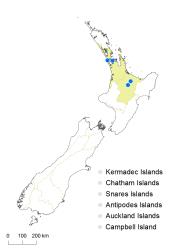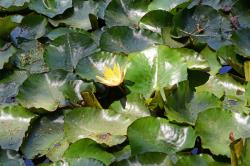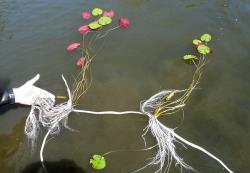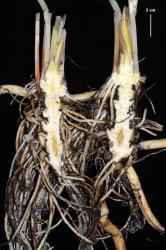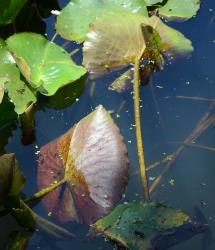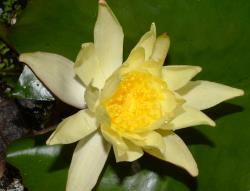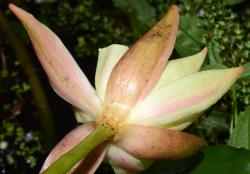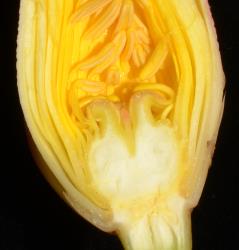- Taxon
- Weed
Perennial, aquatic herb, with thick, erect, non-branching ovoid rhizomes, densely covered in long hairs between the leaf-base scars. Brood-bodies present. Stolons present. Leaves dimorphic (submerged leaves narrowly hastate); stipules adnate; petiole terete, attachment narrowly peltate; floating lamina (35–)110–220 × (35–)90–170 mm, suborbicular-elliptic, shortly cordate to slightly sagittate (lobe margins overlapping), smooth, glabrous, upper surface bright green, sometimes with red-brown or crimson blotching, lower surface red-brown or purplish-green; margin sinuate to crenulate or entire. Flowers 70–120 mm in diameter, flowers held above the water; faint tea-rose scented or odourless; outer tepals 4, 40–90 mm long, elliptic to lanceolate, apex obtuse, outer surface yellow-green, often red-tinted, inner surface yellow; veined. Inner tepals numerous, 25–65 mm long, outermost as long as outer tepals, elliptic to lanceolate, obovate, apex acute to subacute, bright yellow. Stamens numerous, 16–28 mm long, filaments and anthers yellow, anther appendages absent. Ovary syncarpic, globose with ridges, stylar processes oblong-tapered. Fruit spheroid or ovoid. Seeds 3–5 × 3–5 mm, covered in long, finely appressed, hair-like papillae, dull greenish-black.
Distinguished by yellow flowers rather than the white, blue, pink or reds of Nymphaea alba and N. capensis. The leaves are relatively short cordate compared with the latter, and also differ from those two species and many cultivars present in New Zealand by having long, spongy stolons with brood-bodies (a small cluster of buds and banana-like fleshy roots). In addition, the seeds are large, the largest seeds found in Nymphaea, with Johnstone recording them as being 2 × 3 mm and greenish-black when mature.
Nymphaea mexicana is a designated unwanted organism in New Zealand under the Biosecurity Act 1993 and is banned from sale and distribution. It has been controlled in two of its locations, but regrowth from brood bodies and potentially seed has occurred at both sites.
North Island: Northland – Waitakere River, Te Henga wetland (Bethells wetland); Auckland – Van Dammes Lagoon, Mt Wellington; Volcanic Plateau – Lakes Rotokaeo, Ohakuri (Waikato River).
Occurs naturally in south-eastern USA and Mexico.
Growing around the edges of stagnant and gently flowing waters of lakes, ponds, wetlands, streams, canals and ditches.
CHR 140394, L. Nicholls, 15 Jan. 1965, Waikato River, Broadlands end (cited in Johnstone 1982).
Flowering: Dec.–Jan.
2n = 56, 84 (Diao et al. 2006; Gupta 1980).
Nymphaea mexicana is a subtropical member in a generally temperate group of water lilies, N. subgenus Nymphaea. Popular as an ornamental for its yellow flowers, it is now listed as an invasive weed in a number of countries. It is the parent of some hybrid cultivars in ornamental collections. Unusual features are overwintering brood bodies that form on stolons in the muddy substrate (Wood 1959; Johnstone 1982; Garnock-Jones 1988), producing new plants which break off and establish elsewhere. This feature and the characteristic vertical rhizome are represented in the three documented New Zealand populations and are diagnostic of N. mexicana, although N. ×thiona D.B.Ward (Ward 1977), the natural sterile hybrid between N. mexicana and N. odorata, has been suggested as the likely origin of populations in New Zealand and naturalised populations elsewhere (J. Wiersema pers. comm., 2017). However, Johnstone (1982) considered the presence of brood-bodies and fruit (and seed) suggest the Ohakuri plant is not the natural hybrid N. ×thiona.
Hybrids with intermediate morphology between N. alba and N. mexicana have been recorded at Lake Ngātu north of Kaitāia (now eradicated, PDC) and at Bethells wetland, near Te Henga, Waitakere.



